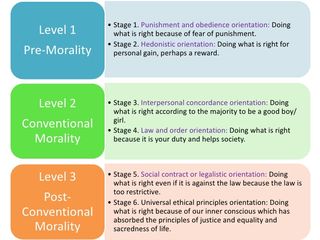Ethics and Morality
Do Children Even Think About Right and Wrong?
Research explains moral psychology in young children.
Posted July 26, 2017 Reviewed by Ekua Hagan

How do children think about right and wrong?
Moral Stages and Broken Glasses
The Swiss psychologist Jean Piaget is renowned for his stage theory of development. According to Piaget, children advance through stages of moral reasoning as they mature.
To study moral reasoning, he presented young children with stories. One story was about two characters. One character innocently opens a door and accidentally breaks 15 glasses. A different character attempts to sneak some cookies while his mother isn’t looking and breaks 1 glass.
Most children said the first character was “naughtier” because he broke more glasses. After collecting many responses to various stories involving morality, Piaget stated that children are unable to take intentions into account when judging the morality of others. They focus on events, not intentions.
Should Heinz Steal the Drug?

The psychologist Lawrence Kohlberg also put forth a stage theory of moral development. Kohlberg presented children with moral dilemmas to determine how children think about right and wrong.
For Kohlberg, young children aged 2-10 determine right and wrong by citing punishment or reward. If something brings punishment, it’s bad.
Take the Heinz dilemma, which Kohlberg presented to young children:
In Europe, a woman was near death from cancer. One drug might save her, a form of radium that a druggist in the same town had recently discovered. The sick woman’s husband, Heinz, went to everyone he knew to borrow the money, but he could only get together about half of what it cost. He told the druggist that his wife was dying and asked him to sell it cheaper or let him pay the rest later. But the druggist said, “No.” The husband got desperate and broke into the man’s store to steal the drug for his wife. Should the husband have done that? Why?
Most young children said Heinz shouldn’t steal the drug. When asked why, they would give answers like, “He shouldn’t steal the drug because he might get caught and be punished.” Many responses to such dilemmas strengthened Kohlberg’s stage theory that young children draw on external sources for moral guidance.
Children Care About Intentions
But more recent research shows that stage theories are misleading. For instance, studies show that if researchers emphasize the intentions of characters throughout a story, along with the help of pictures or toys to help children understand, then children incorporate intentions into their judgments.
One reason why intentions must be emphasized is that it is difficult for children to recall every detail, including intentions, in a scenario. If children are not prompted to recall the intentions behind an individual’s actions, they base their judgments on the most recent feature in a story—the outcome.
But how much do intentions and outcomes matter? Consider the Knobe effect. Research with both children and adults suggest that the judgment of an intention can change depending on the outcome of an action.
In fact, our beliefs about other people’s intentions changes depending on if the outcome of their action is good or bad. If the side-effect of an action has a bad outcome, both children and adults are more likely to think the person intended to do it.
Andy and His Frog
In one study, children aged 3 to 5 were told stories where a character’s actions had a good outcome and another character whose actions had a bad outcome. An example:
Here is a boy named Andy, and he’s over at his house. And here is a girl named Janine, and she’s over at her house. And look what Andy has with him—he has a frog. Now Andy loves frogs, but Janine hates frogs. Now listen very carefully. Andy knows that Janine hates frogs and that she will be really upset when she will see the frog. Andy does not care if Janine will get upset. He is going to bring the frog over anyway.
Researchers asked children if Andy intended to make Janine upset. The 4- and 5-year-olds were more likely to respond “yes.” They also told children another story. This time, Andy brings a frog to Janine’s house, knows that “Janine loves frogs” but does not care if Janine will be happy. In this case, children were more likely to say Andy did not intend to make Janine happy.
The Morality of Side Effects
But why are children and adults more likely to say actions with bad side effects are intentional? One answer is norm violation.
The philosopher Richard Holton claims that our intuitions about intentions are explained by whether an action violates or upholds a norm. If a norm is violated, we view the action as intentional. But if a norm is upheld, we do not view the action as intentional.
Put differently, we think people effortlessly uphold norms, but make a conscious effort to violate them. One norm in society is to avoid upsetting others. If we do something without caring that it will upset someone, we are violating a norm.
Children Are Moralists, Too
In sum, recent research suggests that children’s moral reasoning is more complex than previously thought. Early studies using moral dilemmas were flawed because of their complexity and a misunderstanding of children’s cognitive capabilities. When questions are posed in a clear and understandable way, children mirror the adult tendency to weigh both intentions and outcomes in their moral judgments.
Children are moralists just like the rest of us.
References
Gvozdic, K., Moutier, S., Dupoux, E., & Buon, M. (2016). Priming Children’s use of intentions in moral judgement with metacognitive training. Frontiers in psychology, 7.
Holton, R. (2010). Norms and the Knobe effect. Analysis.
Kohlberg, L. (1971). Stages of moral development. Moral education, 1, 23-92.
Leslie, A. M., Knobe, J., & Cohen, A. (2006). Acting intentionally and the side-effect effect: Theory of mind and moral judgment. Psychological science, 17(5), 421-427.
Piaget, J. (1997). The moral judgement of the child. Simon and Schuster.




